Ever noticed how your friend in New York snagged the latest iPhone for way less than you could buy it in Berlin or Paris? You’d think tech giants would keep their prices pretty similar, but walk into a Best Buy in San Francisco and compare it to a MediaMarkt in Munich—your wallet will notice the difference. That gap is no coincidence, and a mess of tax policies, hidden fees, currency drama, and retail tricks is behind these price tags. Let’s rip the curtain off the shiny shelves and dive into why electronics—from phones and laptops to gaming consoles—are easier on your bank account in the US than anywhere in Europe.
The Real Reason: Taxes and Duties Make or Break the Price
Walk into any electronics store in the US, and try not to get tripped up by the price tags—they often exclude sales tax. That’s right: the price you see isn’t quite the one you pay. But here’s the twist: American sales taxes are almost always lower than those in Europe. Ever heard of VAT? That stands for Value Added Tax, and it sits heavy on just about everything you buy in the EU, including your phone or laptop. Most EU countries levy VAT rates between 19% and 25%. France’s VAT? 20%. Germany? The same. Meanwhile, the average US state sales tax hovers around 6% to 8%. Some states, like Delaware, skip sales tax altogether.
Here’s a quick look at how the final price jumps after taxes:
| Country | Base Price | Tax Applied | Final Price |
|---|---|---|---|
| USA (California) | $1000 | 7.25% | $1072.50 |
| Germany | €1000 | 19% | €1190 |
| UK | £1000 | 20% | £1200 |
| Sweden | SEK 10,000 | 25% | SEK 12,500 |
This tax gap adds up fast, especially if you’re buying high-ticket stuff. And while Americans pay sales tax at the register, Euro-shoppers find VAT baked straight into the shelf price. That sticker shock in Europe is basically the government’s cut, right up front.
But it doesn’t end with VAT. Customs duties are another price driver in Europe. When importers bring electronics into the EU, customs tariffs can land on top of VAT, sometimes depending on the type of gadget or where it was made. The US has its own set of tariffs, but for mass-market consumer electronics, they’re often lower than what Europe puts on the same goods. To put it bluntly: in Europe, governments pile more layers of tax and duty onto your new iPad. Buying the same thing in Los Angeles just dodges a big chunk of that extra cost.
Tip: If you’re traveling, you might hear about claiming back VAT at the airport. Reality check: it’s rarely the full amount, and the paperwork is never fun. If you want true savings, factoring in warranty, compatibility, and currency conversion should come first.

Market Tricks: Why Retail Strategy Favors US Shoppers
Pricing isn’t just about taxes. The whole retail strategy is stacked differently in the US and Europe. Look at population size and sheer demand—the United States is a playground for tech buyers, and brands love volume. When Apple or Samsung launches a new phone, they know the US market will eat up millions of units immediately. That lets them set lower prices, thanks to economies of scale. The more you sell, the less each item costs to make, pack, and put on a shelf. This is classic supply-and-demand, and the US’s giant, unified market is a vendor’s paradise.
Europe, on the other hand, feels like a jigsaw. Sure, it’s the EU, but every country’s got its own language, rules, and tastes. Brands must localize—think manuals, chargers, packaging, and marketing in fifteen different languages. Every tweak is a headache (and a cost). Oh, and distribution isn’t as streamlined, so getting that PlayStation from a warehouse in Rotterdam to a shelf in Barcelona is less efficient than running pallets across the US interstate system.
Then there’s competition. US retailers fight hard for your dollar. Walk into a Walmart, Target, or order online at Amazon, and you’ll see they’re all slicing profit margins razor-thin to lure shoppers. Ever noticed the endless electronics sales around Black Friday, Cyber Monday, or even just random summer blowouts? That’s barely a thing in Germany or France. US retailers build hype, offer zero-interest payment plans, bundle free headphones or streaming services... In Europe, those extras are often rare. You walk in, pay sticker price—freebies cost extra if they’re available at all.
Returns and warranties in the US also tilt the scale. American shoppers expect hassle-free exchanges and liberal return windows. This keeps retailers jumping to please you, often throwing in more value to stay on your radar.
Here’s an insider tip: Online-only US retailers have less overhead, meaning those “web exclusive” deals you see are often the lowest anywhere, while Europe’s stricter consumer protection rules drive up operational costs for e-tailers. The rules are good for you, but make things pricier.

Money Moves: Currency Swings, Licensing, and Big Brand Politics
Just when you think taxes and stores cover it, the money side swings in. Currency matters more than most people realize. US dollar and euro exchange rates bounce up and down, but big brands tend to “round up” European prices—even when currencies get close. For instance, if the dollar slumps, you rarely see a matching cut on Euro prices. Companies stick to safe, high numbers in Europe, which pads their bottom line.
Licensing also chokes up the price chain. Every type of gadget—from game consoles to headphones—has its own list of permissions for Wi-Fi, Bluetooth, streaming services, and data access. Europe’s patchwork of laws and languages means Sony or Microsoft needs a separate license or certification in each market. In the US, one license often covers the whole country. All this bureaucracy eats time, money, and guess what? That all ends up on the shelf price.
Ever wondered about software? A gaming console in the US comes with fewer regional blockers and more bundled apps. That same console in Germany might have limited streaming apps, or some cool features locked due to EU media laws. Guess who pays for adapting and testing every tiny feature?
Here’s a bonus headache: the EU holds strict environmental and recycling requirements on electronics. Think of things like the WEEE label or RoHS compliance (limits on hazardous materials). Meeting those adds complexity and straight-up cost to every imported product. In the States, these checks exist, but they’re more relaxed and unified. Add in eco-taxes, and you realize every gadget is slightly pricier before you even open the box.
The final play here? Big tech brands exploit differences in what people will pay. US buyers expect cutthroat deals, flash sales, and aggressive price-matching. Europeans, historically, are used to slower price drops and fewer discounts. Companies simply set higher “suggested retail prices” based on what past sales show people are willing to spend. It’s not exactly fair, but that psychology shapes the market.
If you’re thinking about flying home with a suitcase full of electronics, weigh up those US price tags against warranty coverage (often region-locked), power compatibility (US uses 110V, EU 220V), and language or software differences. Sometimes that $200 saving washes away if you can’t use your new toy properly after landing. But yeah—when it comes to pure sticker price, the US is king. Knowing these tricks will help you spot the real bargains—without biting on hidden costs later on.







Write a comment